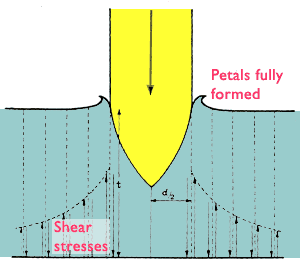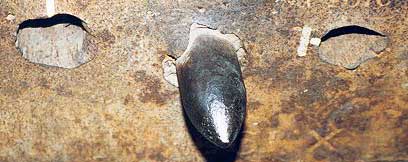
Logo from Scott Cunningham.

Logo from Scott Cunningham.
![]() lug formation occurs in armour plate by a plug of material ahead of the projectile shearing out before the back face tears apart. The back face is ductile enough to resist tearing whereas the material within the plate shears more easily. This is borne out by the fact that some plates giving star cracking failures can be made to give plugging failures by machining off the oxide embrittled back face, thus making the back face more ductile compared to the material within the plate, which remains unchanged.1
lug formation occurs in armour plate by a plug of material ahead of the projectile shearing out before the back face tears apart. The back face is ductile enough to resist tearing whereas the material within the plate shears more easily. This is borne out by the fact that some plates giving star cracking failures can be made to give plugging failures by machining off the oxide embrittled back face, thus making the back face more ductile compared to the material within the plate, which remains unchanged.1

Simplified representation of the shear stresses associated with plug formation. Diagram from 1.
Shear stresses parallel with the projectile’s axis would be expected to fall off roughly inversely as distance from the axis increases, outside the radius of the projectile. It can be shown that plastic deformation extends beyond the cylindrical surface over which shear stress is a maximum and its extent depends upon the work hardening of the plate material. This leads to a small lip at the exit, where the diameter is slightly greater than the diameter of the plug.1

The outer two perforations are examples of plugging caused by 75mm AP attack. Notice the lip on the back face. From the private collection of Chris Shillito.
 Failures Peculiar to Rolled Homogenous Armour
Failures Peculiar to Rolled Homogenous Armour
Do you like this web site? Please rate it between one and ten, with ten being the best:
Ratings are submitted to: The Wargames and Military History Search Engine.
Copyright © 2000 David Michael Honner. E-mail: GvA@wargamer.org.